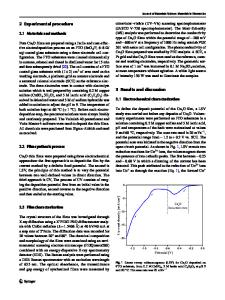Electrochemical Synthesis of Uniform Cu 2 O Film and Its Photoelectrochemical Properties
- PDF / 1,816,536 Bytes
- 10 Pages / 612 x 792 pts (letter) Page_size
- 52 Downloads / 383 Views
ctrochemical Synthesis of Uniform Cu2O Film and Its Photoelectrochemical Properties G. Heidaria, *, **, A. Pordela, and M. Roeinfarda aEsfarayen
University of Technology, Esfarayen, Iran *e-mail: [email protected] **e-mail: [email protected]
Received July 17, 2018; revised July 11, 2019; accepted July 29, 2019
Abstract—Cu2O films as photocathodes were synthesized using direct current electrodeposition method. Utilizing a cyclic voltammetry (CV) test before potentiostatic electrodeposition increased the uniformity and transparency of the Cu2O film. The optical band gap of the Cu2O film obtained through electrodeposition for 7200 s was 2.1 eV, while the one electrodeposited for 1000 s showed a blue shift (2.4 eV). The high transparency of the Cu2O film electrodeposited after the CV test and increased thickness of the electrodeposited film for 7200 s did not affect the value of the photocurrent density. The photocurrent density of the electrodeposited films for time periods more than 200 s did not change considerably. The thickness of the Cu2O film electrodeposited for 200 s was measured to be 70 nm. Electrodeposition for above 200 s resulted in Cu2O films with thicknesses greater than the electron collection length, i.e. 20–100 nm, which was the reason why the photocurrent density was not improved. Electrochemical impedance spectroscopy (EIS) was used to explain charge transfer characteristics of the Cu2O photocathode. The Nyquist plot showed two semicircles, which can be attributed to the charge transfer process across the electrode/electrolyte interface and inside the electrode. The EIS data was fitted with an equivalent circuit and the parameters value was derived. Using the Mott– Schottky plot, the flat band potential and the carrier density were obtained to be 0.19 V vs. Ag/AgCl and 1.3 × 1018 cm–3, respectively. Keywords: electrodeposition, Cu2O, uniform, photocathode, photo electrochemistry DOI: 10.1134/S1023193520030052
INTRODUCTION The depletion of conventional energy resources and the environmental pollution arising from their combustion are the main issues to be addressed in near future [1]. It is a critical challenge to develop a clean, renewable, cheap and sustainable source of energy to meet our growing energy demand [2]. The photoelectrochemical water splitting using solar energy and semiconductors could potentially be used to generate hydrogen as a clean and renewable source of energy [3, 4]. So far, a wide variety of semiconductors such as TiO2 [5], Fe2O3 [6], and Cu2O [7] have been investigated for the photoelectrochemical water splitting. Cu2O, as an important p-type semiconductor, has recently attracted considerable attention in many areas such as photocatalytic conversion of CO2 [8], super capacitor [9], photocatalysis [10], battery [11], solar cell [12], optoelectronic devices [13], and photoelectrochemical water splitting [14]. It has an ideal band gap from 1.9–2 eV, which guarantees the efficient harvesting of solar light, particularly the visible region [15]. Besides, it contains ear
Data Loading...











